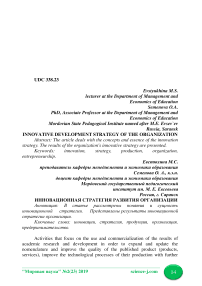Innovative development strategy of the organization
Автор: Evstyukhina M.S., Semenova O.A.
Журнал: Мировая наука @science-j
Рубрика: Основной раздел
Статья в выпуске: 2 (23), 2019 года.
Бесплатный доступ
The article deals with the concepts and essence of the innovation strategy. The results of the organization's innovative strategy are presented.
Innovation, strategy, production, organization, entrepreneurship
Короткий адрес: https://sciup.org/140264212
IDR: 140264212 | УДК: 338.23
Текст научной статьи Innovative development strategy of the organization
Activities that focus on the use and commercialization of the results of academic research and development in order to expand and update the nomenclature and improve the quality of the published product (products, services), improve the technological processes of their production with further
introduction and efficient implementation in the domestic and foreign bazaars, called innovative work . [1]
In the main, modern work of the company is focused on increasing the competitiveness of the published products (service).
The result of innovative work are: the newest thoughts, the newest food products, the improved food products, the improved or the absolutely newest technological processes.
Created new items can be broken into: the newest with the aim of society; the latest for the purpose of the state; the latest for the purpose of a single enterprise (category of enterprises).
Also, innovation can be divided based on the depth of the changes. Highlight innovation:
-
• radical (basic);
-
• improving;
-
• modification (private) [3].
These types of innovations vary in the degree of coverage of the life cycle stages.
One of the main prerequisites for the development of innovative strategy is the obsolescence of the output products (goods, services) and technology [1].
In the process of innovation work, changes are made in the economy, in various sectors of the industry, in the public sphere, in the actions of consumers, in the minds of managers and employees of companies. For this reason, the created policy of innovation work must understand the stock exchange, adhere to its needs.
In order to embody the strategy of innovation work, the company must have an optimal coordinating texture and a kind of mood that contributed to the formation of an entrepreneurial atmosphere, an atmosphere of perception of the newest in no way equal to danger, but also favorable ability. To any employee of the company must come an understanding of this, that the policy of innovation work is the best way to form a company and increase its competitiveness. Thus, after all, a competently created policy of innovation work will enable the enterprise to rise in the future and achieve success [2].
The uniqueness of any organization makes its mark in the course of the formation and implementation of the strategy of innovation, but in this case, after all, absolutely all companies select the strategy for the selection of organizations at the base of considering significant and insignificant company edges and scope. Any company to try to make the greatest use of existing abilities. Thus, in fact, in the strategy of innovation work significant importance is represented by the economic abilities of the company, the high qualification of employees and the transient condition [4].
In the course of the implementation of the strategy of innovation in the enterprise passes a large number of innovative processes. These processes can be divided into the following phases (stages):
-
• achievements of fundamental science;
-
• applied research;

-
• experimental development;
-
• primary development (implementation);
-
• widespread adoption;
-
• use;
-
• obsolescence [5].
The choice of the optimal strategy is for the enterprise the key to the success of innovation.
Innovation strategies can be divided into the following types:
-
1. Offensive. This strategy is used by enterprises that base their activities on the principles of entrepreneurial competition.
-
2. Defensive. This strategy is used by enterprises that are trying to maintain the competitive position of the company in existing markets.
-
3. Imitation. This strategy is used by firms that have strong market and technological positions.
The strategic innovation approach involves seven areas, the development of which will ensure business growth:
-
• Managing the process of searching and introducing innovations (using nonstandard and classical approaches to strategic planning).
-
• Strategic adjustment (providing assistance to key managers regarding vision, goals, strategies and issues).
-
• Industry foresight (views emerging trends).
-
• Understanding the consumer (presenting clear and controversial customer needs).
-
• Key technological processes and competencies (the ability to implement new ideas).
-
• Disciplined implementation.
Список литературы Innovative development strategy of the organization
- Karpova, S.V. Innovative marketing. Textbook / Ed. - S.V. Karpov. - M.: Yurayt, 2016. - 458 p.
- Creative management. Social, psychological and creative aspects of labor economics. Textbook / O.E. Bashina et al. - M.: Infra-M, Forum, 2015. - 272 p.
- Maltseva, S.V. Innovation management: a textbook for academic bachelor / S.V. Maltseva; rep. ed. S.V. Maltseva. - M.: Publishing house Yurayt, 2019. - 527 p.
- Tebekin, A. V. Innovation management: a textbook for bachelors / A. V. Tebekin. - 2nd ed., Pererab. and add. - M.: Yurait Publishing House, 2017. - 481 p.
- Spivak, V. A. Change Management. Textbook / V.A. Spivak. - M.: Yurayt, 2016. - 358 p.


